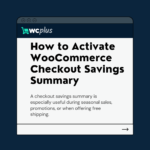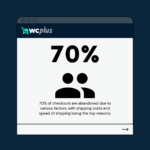Did you know smartphones accounted for approximately 78% of commerce site visits in 2023?
Most people do not want to wait until they are at their computers before purchasing online. As a business, you must ensure your checkout pages give your visitors a fantastic user experience regardless of their screen size.
What is a Mobile-Friendly Website?
Although you would assume that a mobile-friendly website makes accessing content easier without causing text or image distortion, it accomplishes more.
A mobile-friendly website is designed to function efficiently for users accessing it from their smartphones or tablets. It does this by customizing content that is not found on the regular version or removing unhelpful content.
For example, you could remove large pop-ups that expand past the width of your mobile users’ screen to provide them with a seamless mobile checkout experience.
When designing a mobile-friendly checkout webpage, you must keep your customers’ unique needs from their mobile devices in mind. Let’s consider some of these needs.
Considerations for Creating a Mobile-Friendly Checkout Page
Spacing
Since most mobile devices are touch screens, mobile shoppers usually use their fingertips rather than an external mouse to navigate item options and click on links. You must ensure that you adequately space checkboxes and form fields to ensure the mobile user will have no trouble inputting their information to create an account.
Touchable Elements
Please ensure that touchable elements like buttons are large enough for your users to access them. For example, if your “Input Credit Card Details” button is too small, it would make the payment process too stressful, discouraging potential customers and causing them to abandon their carts.
The recommended minimum touch target size is approximately 48×48 pixels to fit standard fingertip size. This implies that you risk getting low conversion rates and more cart abandonment cases if you make your buttons smaller.
Visual Hierarchy
Research has shown that the average person has an attention span of 8 seconds. This means you have this much time to catch and direct their attention.
You’ll need to get some information on your mobile website so you can prioritize essential details.
Using a clear visual hierarchy guides users effortlessly throughout your content, provides them with a seamless mobile checkout flow, and ensures that you attain a high conversion rate.
Progressive Disclosure
Although you must provide your users with essential details, you must refrain from giving unimportant information to eliminate distractions.
Progressive disclosure helps you introduce information to new users gradually by providing them with only the bits they need at every step.
For example, to implement a fast checkout in the mobile payment process, you must first prompt the user to choose from the available payment options before displaying the relevant form fields to collect payment details based on the payment method clicked.
Mobile Keyboard Optimization
Unlike desktop users who use a manual keyboard, mobile shoppers use mobile keyboards that could take up to 60% of their screen.
You’ll need to design your forms and mobile checkout flow to work well with portable keyboards and optimize mobile checkout experiences.
One way of doing this is using input masks to provide a visual guide when collecting customer data, such as phone numbers and other order details.
Important information such as CTA buttons, total price, trust seals, order total, and promo codes should be placed above the mobile keyboard to make it easy for users to see them.
You can apply these principles to make your checkout pages mobile friendly. Let’s consider a few ways to optimize your checkout page on mobile screens.
Best Practices for Optimizing Your Mobile Checkout
Eliminate Pop-Up Ads
Consider a situation where a new user shopping from a small screen gets a huge pop-up when they try to fill out the checkout form. And when they try to dismiss it, it doesn’t go away at a single click. Pop-ups like these slow down checkout flows and cause customers to abandon their shopping cart when they attempt shopping on their mobile screen.
Pop-ups that might have been easy to dismiss with a single mouse click for desktop users are frustrating for mobile users.
One of the essential best practices to keep customers and ensure they have a good shopping experience on their mobile devices is to eliminate these frustrating pop-ups.
Use Short Forms
Although it is vital to collect essential user details, you must refrain from bombarding them with endless forms they have to fill. Mobile users often shop on the go, and you risk a high cart abandonment rate when you require too much information from them before they finish the checkout process.
The number of form fields you use should be as few as possible to ensure your customers complete transactions and attain customer satisfaction.
You could also use the WC Plus Address Autocomplete feature to help users fill forms faster.
Keep Users on the Checkout Page
Mistakes happen. And if customers have to go to a different page to make changes before they complete their purchase, you risk low mobile conversion rates.
For example, users abandon their carts more if they have to double back and leave the checkout page to make adjustments before they complete their purchases.
Implementing processes that keep users on the checkout page allows users to make all corrections on one page and helps reduce cart abandonment.
Replace Links With Buttons
It is much easier for mobile shoppers to click on a big button that says “Add to Cart” on their mobile screens than to click on a line of highlighted text.
A CTA button (call-to-action ) or an action button will force users to pay attention to important information and prompts on their mobile screen.
Accept Several Payment Options
Offering only one credit card payment option implies that you do not cater to mobile users who can’t use that option. This makes smartphone users abandon their shopping carts and filters out some potential customers.
Ensure your checkout process accepts multiple payment options so mobile users can complete purchases using their preferred payment methods.
Since you know what to consider to make your eCommerce checkout mobile-friendly, let’s consider why a tremendous mobile checkout experience is essential.
The Importance of Mobile-Friendly Checkout Pages for E-Commerce
Increased Mobile Checkout Conversion Rates
Every business’s goal is to make a profit, and your mobile UI increases your chances of doing so when consumers can smoothly complete purchases on your mobile app or mobile site.
You allow users to add items to their carts and make payments without distractions when you make your checkout pages mobile-friendly.
Improved User Experience
A good mobile-optimized checkout page will have a shorter load time. This means that users will spend less time in your online store waiting for information to load or waiting for action buttons to appear before they click checkout.
With a better buying process, you provide your online shoppers with better customer service and boost commerce sales.
Increased Customer Loyalty
Consumers like to feel safe. And you earn their loyalty when you allow them to make secure payments using their preferred payment methods.
For example, a new user who’s used to making online payments using PayPal or Apple will question your integrity when you have only one payment option, which is neither of the two.
Improved Search Engine Rankings
Search engines like Google give mobile-friendly websites preference in search results. This implies that you increase your mobile site’s traffic by appearing high in search results when users search for items or services you offer.
With more traffic and a fantastic buying experience, you are guaranteed to increase conversions and boost sales.
Competitive Advantage
Customers are more inclined to choose a business with a simple, easy-to-use mobile checkout page. If they have too many difficulties using your mobile site when purchasing on their smartphones, they’ll switch to one of your competitors.
Designing your mobile checkout page to be mobile-friendly helps direct customers to your eCommerce site when they abandon others for being unresponsive.
Greater Accessibility and Reach
With a mobile-friendly checkout page, users who shop primarily from their mobile phones would have access to your e-commerce site.
This increases your reach and caters to customers that would have otherwise been left out.
Positive Brand Reputation
Offering your users a great mobile shopping experience reflects positively on your brand and helps you build trust with your customers.
Customers who have shopped leave positive reviews that encourage potential customers, and some even go as far as posting about you on their social media pages, generating sales for you.
Conclusion
With new mobile devices and mobile technologies, people are more willing to shop online from their mobile phones. Maintaining a mobile-friendly checkout helps you adapt to these changes and stay ahead of changing user preferences.
Do you still need help implementing mobile responsive features on your checkout page? Install WC Plus to provide the functionality of 10+ plugins and more to give your customers mobile-friendly and secure eCommerce checkouts.







